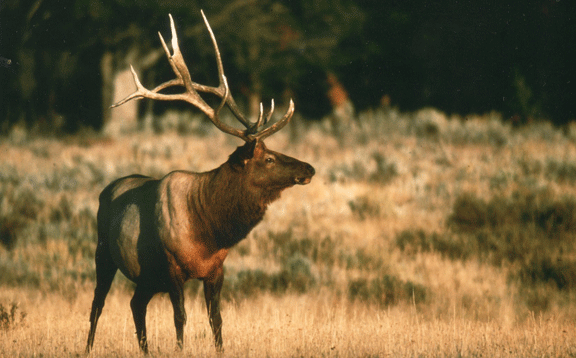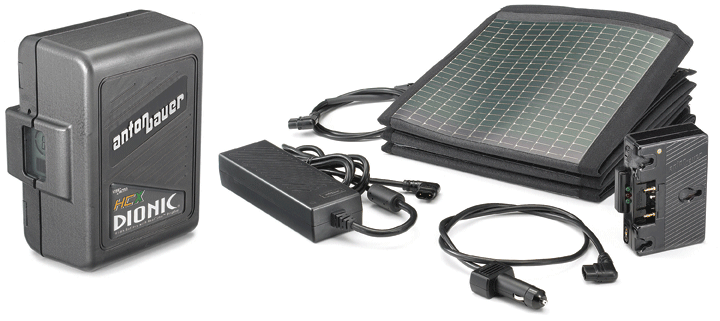|
Harsh, isolated locations can
make reliable batteries a primary concern.
By Buck
McNeely
- Way back in 1990, I built what was then
a state-of-the-art Sony Beta SP A/B roll
linear editing system. I also bought a Sony
BVW 5 Beta SP camcorder with a Fujinon lens.
I was five years into producing my TV
program The Outdoorsman with Buck
McNeely. We launched it commercially on
one TV station in Cape Girardeau, Missouri
in 1985. For the first five years, we shot
on 3/4” tape using a deck attached via
umbilical cable to a Sony M3-A tube camera.
I had to hire cameramen with strong backs
and weak minds to pack that system into the
bush.
- I was very proud of that new Beta SP
camera. Direct from the factory it had a
drop in sled on the back that accepted one
NP1-A battery. I started shooting in some
interesting locations in the early 90s and
bought several NP1-As to carry along. We
shot in Africa, New Zealand, Russia, Mexico,
Argentina, and many other locations
worldwide. And we lugged eight of those
heavy batteries into the field every day.
It was on an elk hunt in Colorado that I had
to rethink my long-term battery/field-power
production strategy.

- Let me set the stage. It was COLD. Two
feet of snow covered the ground. The pines
and spruce trees looked like frosting dipped
popsicles. (Did I mention it was cold?)
- I had a guide named Dirk. He was a tough
little cowboy type who maybe weighed 120
pounds with rocks in his pocket. That Man
could hump those mountains though. We did
some serious hiking the first three days. We
hiked to ridgelines to glass into valleys
looking for elk. We ghosted among stands of
aspens scarred with chest high nips in the
bark both old and fresh.
- Elk will chew bark off aspens in snow
pack when no other food is available.
Millions of aspen trees in the West sport
these markings.
- We spotted a few cows and young rag-horn
bulls. No shooters, though. The animals were
moving down from the high country into lower
elevations looking for food.
- On day four, we were driving along an
old fire road and I just happened to glance
up a mountain. Way up the slope I spotted
the outline of a dark-bodied elk bull in a
snow-packed clearing above a stand of pines.
- “Stop the truck!” I exclaimed.

- We dismounted and I put the binos on the
bull. I beheld the biggest elk bull I had
ever seen pawing the snow rooting for graze
underneath. He was tiny in the binos and
just slightly bigger in the cameras
viewfinder on 2x extender. I could see what
appeared to be a Christmas tree on his head.
It was a BIG rack of antlers.
- “What are you doing today?” Dirk asked.
- “We are going to get up that mountain,
shoot that bull and capture some award
winning footage today,” I stated with a big
grin.
- Dirk and I glassed the mountain and
crafted a strategy to get up above and
behind that bull. We loaded up the camera
gear and proceeded to motivate up that
mountain. As I closed up the truck I grabbed
an extra battery and stuffed it into an
inside jacket pocket. Reserve power.
- After two hours of laborious slogging
uphill in two feet of snow, we moved into a
pine tree belt overlooking the elk’s last
known location. Dirk peeked around a thick
blue spruce and turned to me with a big
smile.
- “The bull is facing away from us at 90
yards.” He whispered. “He’s carrying the
biggest rack I’ve ever seen.” His eyes were
buggin’ out.
- I turned to my cameraman and whispered
to him: “Fire up the camera, zoom out wide,
put your left shoulder two feet behind my
right shoulder. We are going to ease out
together, the camera rolling. You’ll have
two seconds to focus and compose the shot.
I’ll hold off as long as I can before he
gets wise. I may have to shoot quickly so be
ready. Get your shot, then I’ll take mine.”
- He fired up the camera and then… we
heard it power off.
- “Dead battery, the cold sapped it,” he
said.
- I reached into my inner jacket and
pulled out a warm battery. We swapped the
bad one out, fired up the camera and eased
around that tree ready for action. All I saw
was snow. No elk. I froze, looking around
that opening. It was dead silent, no
movement. No elk.
- “He spooked off.” Dirk muttered off my
other shoulder.
- We walked into the clearing and saw
where his tracks had packed the snow during
his visit. We also spotted where he jumped
and dug in with his hind hooves and started
his bolt down the mountain, quartering away
from us.
We puzzled out what must have happened
as we followed his downward trail for
several hundred yards. When we swapped out
batteries there were a couple clunks in the
process. In that high Alpine stillness, that
bull heard that unnatural sound in his
living room. He didn’t wait or go what’s
that noise? He just slipped out the back
door, at a run. He was a wise old bull and
escaped my freezer that day.
A mental image of that big bull is
burned into my brain. It recurs at times in
dreams, just to remind me of how the dice
tumble in life.
After that production, I ordered up some
new Anton/Bauer batteries and put a gold
mount plate on the back of that Beta SP
camera. I had lost an opportunity to shoot
and film a world-class bull elk due to power
failure. I resolved not to let that happen
again.
Back then, Anton/Bauer had a workhorse
battery, the ProPac 14, known affectionately
as the “Brick.” I picked up a few of those
and their smaller TrimPac batteries. Over
the next few years I travelled the world
filming in more exotic and remote locations.
We shot in Arctic Tundra, sweltering
jungles, hot, cold, mountains, deserts and
oceans. You name it, we went there. We
logged some serious miles with that Beta SP
camera and those Anton Bauer batteries. To
date I’ve not missed another shot due to
power failure.
In 2000, we started shooting with the
Ikegami Edit Cam. This became my primary
camera until we upgraded to HD in 2007. The
Ike was a sweet digital camera that recorded
on a 90GB hard drive called a "field pack."
We also got an upgrade in battery power when
Anton/Bauer introduced the Digital DIONIC.
This Lithium Ion technology was a major
step up in technology from the old lead acid
batteries. In the field it lasts longer and
is more cold resistant. The DIONIC also
charges faster. It’s my opinion it is the
dominant field battery in the industry. That
statement is based on extensive field
performance worldwide over many years.

- Today, I shoot with a Panasonic
AJ-HDX-900 HD camera (above) and Fujinon
HA22x8.7 BERD zoom. I also mount the
Marshall LCD651ST field monitor on top, run
a Litepanels Micro Pro LED light and have an
Azden 1200 series drop-in wireless receiver
onboard. I’m using a hybrid tripod system
featuring a Sachtler head on a Manfrotto
carbon-fiber tripod. I also use a Panasonic
HVX-200 recording on P2 cards as my second
unit. In the field, I dump P2 files on a
Nexto NVS 2500 drive. I protect all this
gear with Petrol equipment bags and rain
covers.
- Now, Anton/Bauer has introduced the
Dionic HCX battery. HC stands for High
Current. These batteries are designed for
power-hungry cameras that also run
accessories like a light and monitor off the
battery power. You can expect to get two
hours run time with a 40-watt camera and a
20-watt light from each charge. This battery
also features an advanced LCD RealTime Fuel
gauge. This new LCD display accurately shows
the user the actual remaining run time and
battery capacity. The other new feature is
it has a built-in motion detection sensor.
After a two-day period without a load, the
Dionic HCX automatically goes into “deep
sleep,” reducing self-discharge and allowing
extended storage with nearly zero capacity
loss. It reactivates when you pick it up.

-
Anton/Bauer's Dionic HCX battery (above,
left) has made life easier for McNeeley —
their
solar-powered Tandem 150 charger system
could keep him in the field even longer.
- Battery technology has evolved a long
way in the 25-plus years I’ve been
producing. Smart technology has reached this
critical camera element and into the future
I see even greater developments in
miniaturization and even longer run times.
Now if I can get them to build a two-hour
battery about the size of a deck of cards
that also keeps beer cold, I’ll try to
forget about the elk that still haunts my
predatory dreams.
- Buck
McNeely is producer-host of the world’s
largest syndicated adventure series,
The Outdoorsman with Buck McNeely. Visit
www.outdoorsmanint.com
for more info.
|
